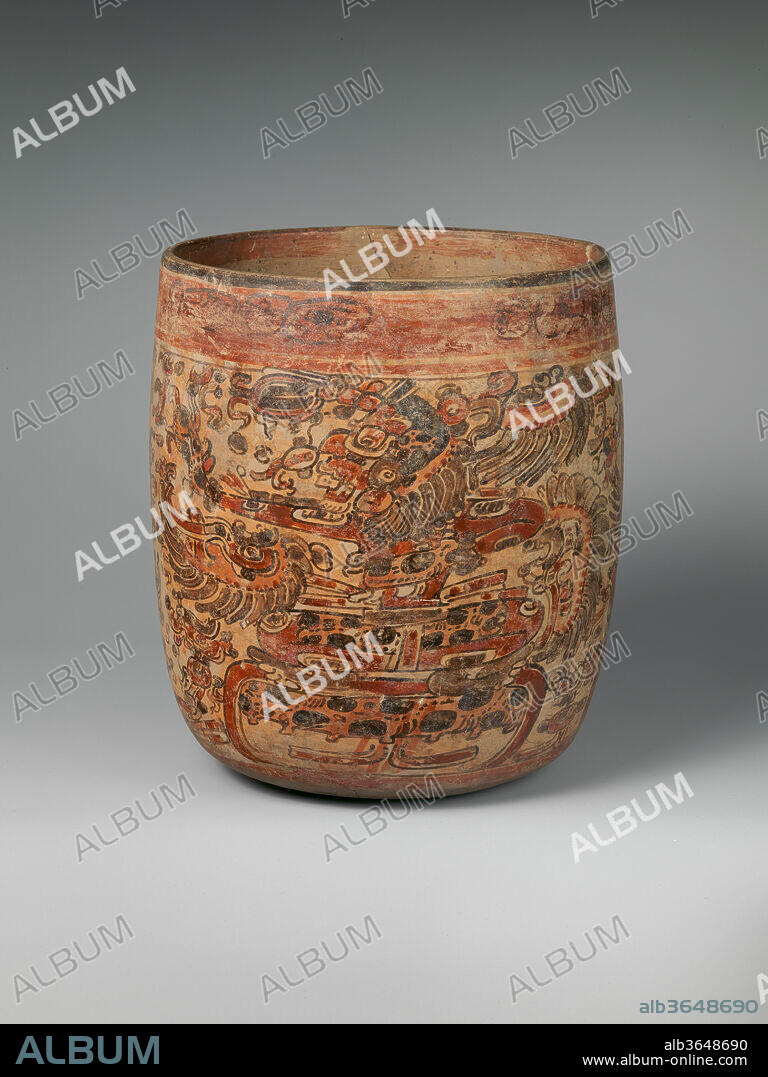alb3648690
Vessel, Seated Deities

|
Add to another lightbox |
|
Add to another lightbox |



Title:
Vessel, Seated Deities
Caption:
Vessel, Seated Deities. Culture: Maya. Dimensions: H. 8 3/4 x Diam. 7 1/2 in. (22.2 x 19.1 cm)
Diameter: 7 1/2in. (19.1cm). Date: 6th-7th century.
This large, barrel-shaped polychrome cylinder vessel contains three images of a deity seated on thrones around its body. The rim of the vessel contains a band decorated with lightly painted pseudo-glyphs, images that give the appearance of writing without being actually legible. The baroque scene with the deities, covered in jewels and elaborate regalia, may pertain to a long-lost Maya myth from the 5th-6th centuries. The deity depicted in the two scenes sits cross-legged and raises its right arm while folding its left arm over its torso. The body of the deity is painted red and decorated with pill-shaped motifs that have been identified as marks of shininess in Maya art. Though the feet of the deity, painted in a gray wash, appear human, the gesturing hands are in the form of clawed jaguar paws. The loincloth is also a jaguar pelt, as is the cushion of the throne. The jaguar ears, along with the square-shaped eye with spiraled pupil, "cruller" ornament that frames the eye, and down-turned mouth with prominent tooth, all mark this deity as the Jaguar God of the Underworld. This deity is associated with the night sun. A similar vase, perhaps created in the same workshop, depicts the same deity holding a quatrefoil medallion of the Jaguar God of the Underworld (Hudson Museum, Orono, HM638).
The artist's horror vacui is evident in this scene. Every surface of the gods' body is dripping with feathers and jewels; entire wings, animated with the jawless head of a reptilian creature, extend from their elbows and flare into the interstitial space. This style of painting has been associated with pottery naming the ruler of Naranjo, Aj Wosal Chan K'inich, who ruled from A.D. 546 to around 615. Naranjo, a large city in the east of Petén, Guatemala, was an important center for painters of pottery vessels for many centuries.
Owners of this vessel prized it so much that when it fractured in antiquity, they drilled holes on either side of the crack to repair with a binding fiber.
James Doyle, 2016.
Technique/material:
ceramic
Museum:
Metropolitan Museum of Art, New York, USA
Credit:
Album / Metropolitan Museum of Art, NY
Releases:
Model: No - Property: No
Rights questions?
Rights questions?
Image size:
3150 x 4200 px | 37.9 MB
Print size:
26.7 x 35.6 cm | 10.5 x 14.0 in (300 dpi)
 Pinterest
Pinterest Twitter
Twitter Facebook
Facebook Copy link
Copy link Email
Email

